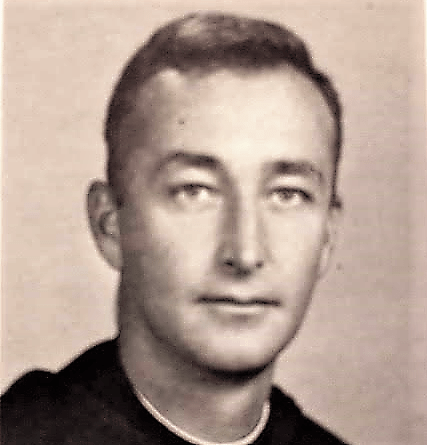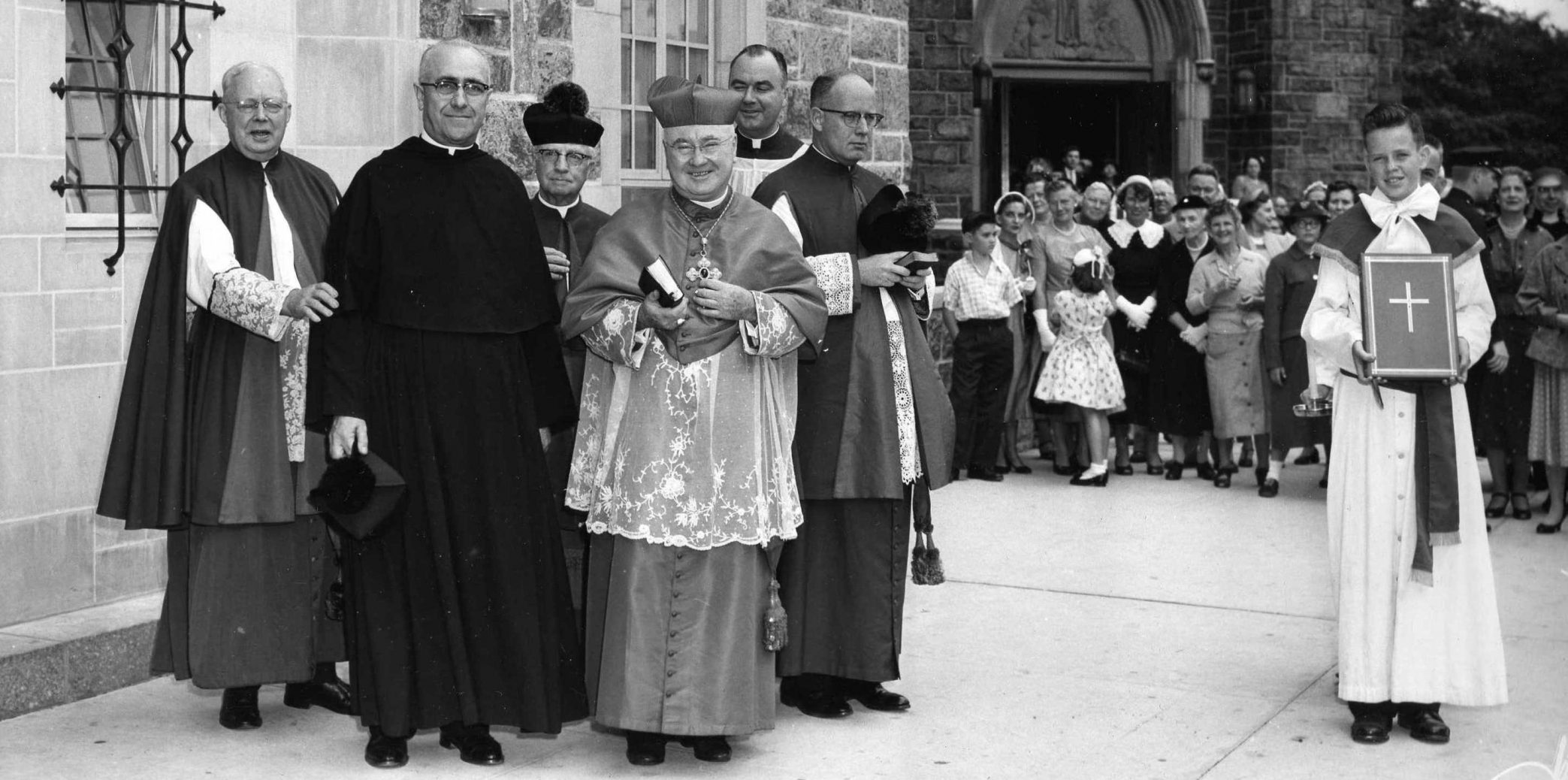
History
At the turn of the previous century, (1900) New York City experienced rapid population growth with the influx of immigrants in many sections of the city, especially in the outer boroughs. Outer boroughs, which were once bucolic settings were being transformed into bustling cityscapes. The extension of the subways up to the University Heights area of the northwest Bronx brought many Catholics to the area. In 1905, by invitation of the Archdiocese of New York City, the Order of St. Augustine founded St. Nicholas of Tolentine Parish. The very first mass was celebrated in a small brick garage on North Street, just west of Jerome Avenue. The first pastor, Reverend Edward G. Dohan, O.S.A quickly began work to build a new church and parish offices between Andrews Avenue and Fordham Road that would be able to accommodate the growing parish. The building was a combination of a parochial school-over-church building, with a separate rectory. The cornerstone was laid by Monsignor J. F. Mooney V. G. on July 15, 1906. The parish grew rapidly and the following pastors purchased new lots of land (where the present church is) for the current and anticipated growth of the parish. For more information about each pastor, and their role in the history of St. Nicholas of Tolentine Church, click on this link: Augustinian Friars- St. Nicholas of Tolentine Church.
In 1917, the new pastor of St. Nicholas of Tolentine Church, Fr. Blase J. Zeiser, O.S.A. saw the immediate need to purchase even more property as the church and neighborhood continued to grow rapidly. It was Fr. Zeiser’s vision to build a large church that would meet the current needs and any future needs of the parish. In 1927, the cornerstone was laid for a Gothic style structure, with massive twin towers framing the faćade, salient buttresses, and rose-windowed transepts forming the sides. This present church was designed by the architectural firm Delaney, O’Connor & Schultz and was dedicated on April 29, 1928 by Cardinal Hayes. It was, at that time, the largest parish church in the Archdiocese. Father Zeiser continued to guide his flock through the Depression and the lean years of the late 1930s, right on through World War II.
In 1942, a patriotic flag dedication/raising event was held at Tolentine and included the participation of Mayor Fiorello H. La Guardia. A program from this event was sent to us from a family whose relatives were Tolentine parishioners years ago. We scanned the program and you can view it as a flip book (see below). When you scroll down, keep your cursor to the far right so you will be able to scroll down far enough. Otherwise, the cursor will only enlarge the book, not allowing you to scroll down far enough. If you need to enlarge a page, you may do so by clicking on the magnifying glass + or – just below the book. If you are viewing on a cellphone, the flip book is best viewed with the phone held horizontally.
You will notice the doors on the left and right of the front of the church are not present in this 1942 picture. The only doors at that time are in the center, and to the left and right are stained glass Trinity windows.
In the late 1950s, just after Tolentine’s 50th anniversary (September 9th, 1957) and when the upper church was completed, a lovely parish history book was published by the church. Only a couple of these books remain, so we have scanned it and reproduced it as a flip book (see below). When you scroll down, keep your cursor to the far right so you will be able to scroll down far enough. Otherwise, the cursor will only enlarge the book, not allowing you to scroll down far enough. If you need to enlarge a page, you may do so by clicking on the magnifying glass + or – just below the book. For iPhone users, the flip book is best viewed with the phone held horizontally.
The book has two pages that have fold outs. In the flipbook below, we have included those pages, but not the part of the page that folds out. We included those in picture form just below the book.
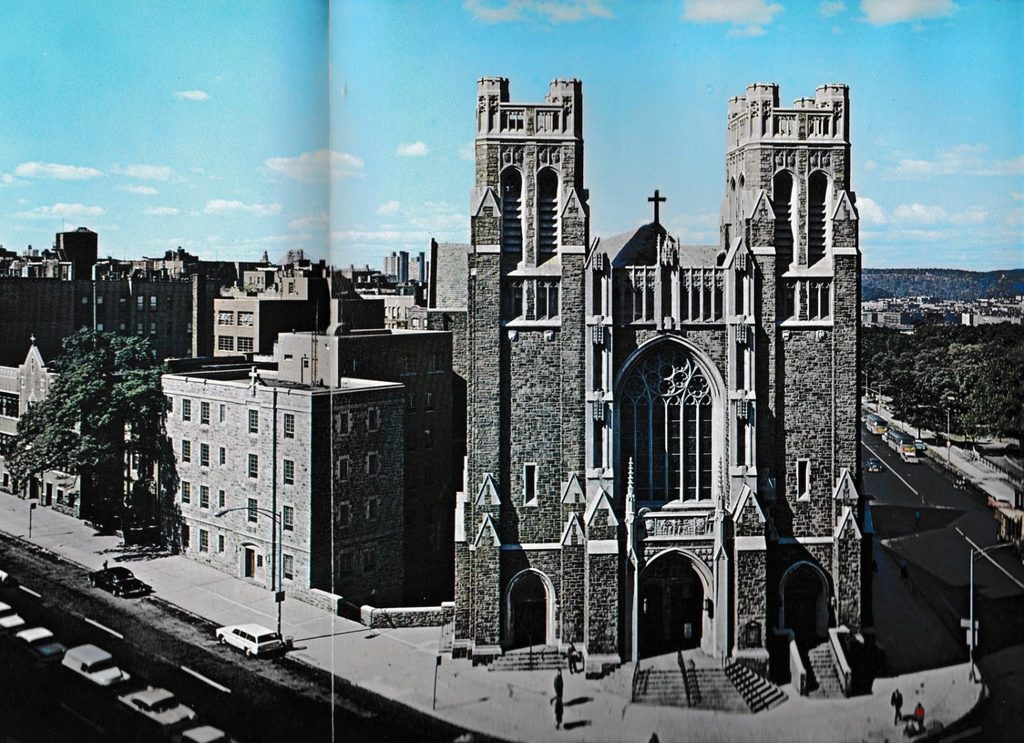
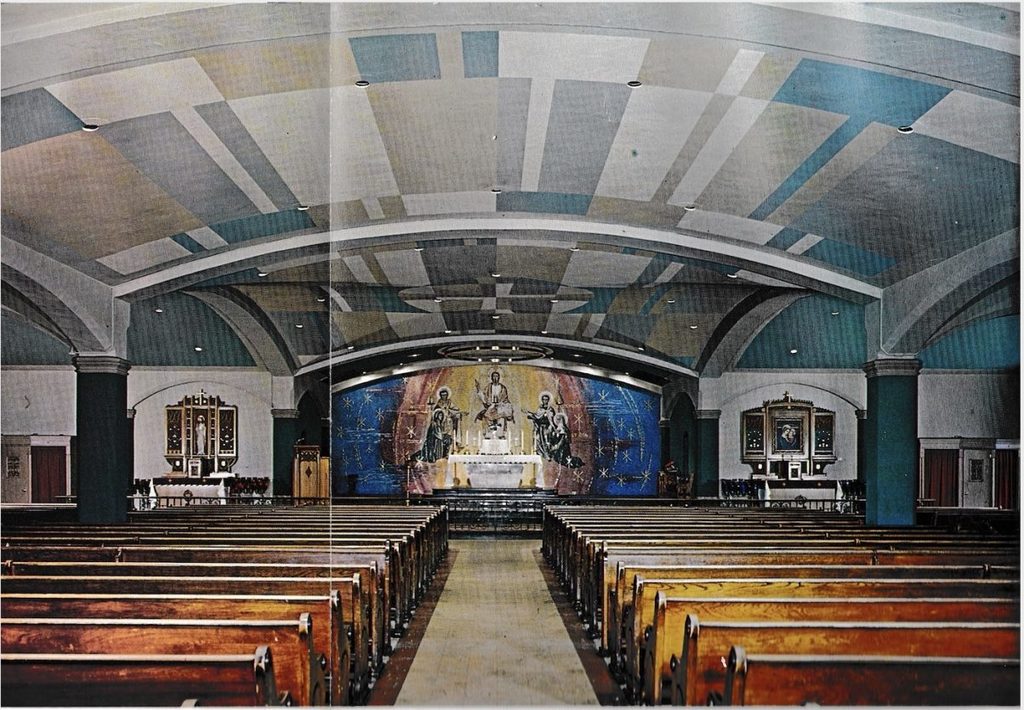
This picture is one of the few pictures we have of the lower church before it became the Father Smith Center.
The Reverend M. Eugene Mauch, O.S.A., was the pastor from 1946 to 1953 and he oversaw the completion of the interior of the new upper church, including the installation of our wonderful pipe organ. The mid to late 1950s saw the completion of a new (current) rectory, a new modern high school, and a new central heating plant.
In 1959, St. Nicholas of Tolentine Church had a full time staff of nearly 70 people, exclusive of clerical, secretarial, housekeeping and maintenance. There were 21 priests – the pastor, 4 associates, 8 priests in the high school and 7 priests in the grammar school.
The picture at the very top of this page is from the late 1950s and shows the blessing of the new (current rectory).
Second Vatican Council – the 1960s and onward
The Second Vatican Council and cultural shifts of the 1960s brought change to St. Nicholas of Tolentine parish. Traditional services, Latin Masses, and music were abandoned in favor of the popular trends of the period. Folk masses with guitars were added and often replaced choral music and organ. Fortunately, our pipe organ survived this period and wasn’t sold or thrown out like in so many churches during that time. St. Nicholas of Tolentine had a second pipe organ located in the sanctuary near where the piano currently sits. In 1979, the decision was made to sell the Jardine pipe organ (pictured below) and use the proceeds of that sale to help keep the large organ in the balcony maintained.
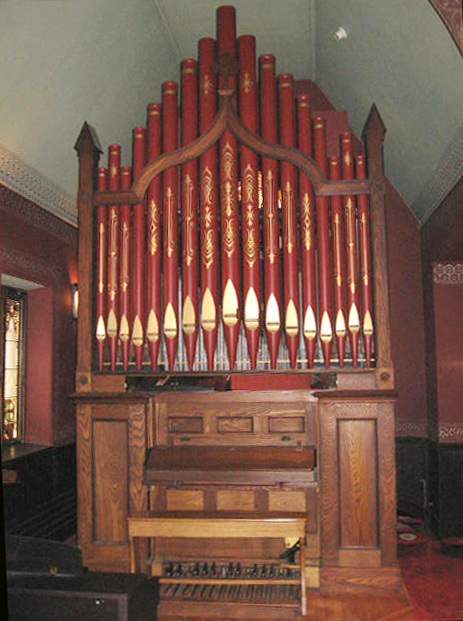
In the late 1970s, the lower church (two pictures above) was converted to the Tolentine-Zeiser Center (now Father Smith Center). A drop ceiling was installed (crypt ceiling was and remains covered) and partitions were built for office space along one side and the back. The center began as a senior citizen center offering lunch, Meals on Wheels, and activities for seniors. The center programs expanded (also to other parochial buildings and buildings in the surrounding neighborhood) to include a food pantry, day care, Universal Pre-K, The Asian Center, Housing for Single Homeless Mothers & Children which provided single mothers a home and address for a year along with the opportunity for education and job training and transition to permanent housing. As a response to the AIDS crisis, a residence for people living with AIDS/HIV was established on the Grand Concourse. Several of these programs were eventually phased out.
The Father Smith Center is named after Fr. Alfred E. Smith, who was assigned to St. Nicholas of Tolentine Church in 1979, at first as a high school teacher, and later as the Associate Pastor. Fr. Smith was known for his ability to work with the elderly, the parish youth, and those dealing with addiction. On July 12, 1986 Father Smith died suddenly at 54 years old, of a massive coronary as he was preparing to celebrate the early morning mass. His death was staggering loss for all those who knew him.
(Also of note, Fr. Smith’s grandfather was Alfred Emanuel Smith (Al Smith), the American politician who served four terms as Governor of New York and was the Democratic Party’s candidate for President in 1928.)
For more information about Fr. Smith, click on the image below.
Fr. Alfred E. Smith (1931-1986)
New Communities Arrive
Many Spanish-speaking immigrants arrived in New York during the 1970s. At the same time, with the ever increasing popularity of the car and post-WW II suburb development, many families left city life for the suburbs.
Spanish Masses were started as the Spanish-speaking community grew, and as a wave of Vietnamese immigrants arrived, Vietnamese Masses were added. Now there are masses said in each language, with major liturgies celebrated in English, Spanish and Vietnamese.
High School Closes 1991
In 1975, St. Nicholas of Tolentine’s high school was ranked No. 1 in the nation. Known not only for its academic excellence, it was also know for its basketball programs and teams which won many tournaments. But changing times, declining enrollment, social, and economic factors played a role in the closing of the school in 1991.
100th Anniversary 2007
In 2007, the parish celebrated its 100th Anniversary. Several special celebratory activities and masses were held, including a special 100th Anniversary Concert given by our choirs.
2010 Fire
On March 5th, 2010, just before the 12:10 pm mass, an arsonist set fire to the lobby of the church. Bags with accelerant material were placed in an old confessional that was located to the side of the lobby. Bags with accelerant were also placed at several exits. Parishioners were in the church at the time and alerted the pastor, Fr. Joseph Girone, O.S.A., who managed to help everybody escape through the chapel and rectory. Thankfully, nobody was injured, but the fire did cause considerable damage, including the complete loss of the oak coffered ceiling, all the oak doors and frames around the doors. The fire was so intense it even destroyed the stonework. The church was closed for several months, and masses were moved to the school gymnasium. A very extensive and expensive rebuilding ensued, with diligence that what was there was to be put back, with the highest quality of work, including replicas of the oak ceiling and doors and frames. New stone work was also cut and installed. As a sign of “ashes to new life” the remains of the elaborate door frames were reconditioned to become part of two devotionals that are currently located in the north and south transepts of the church.
Flames had started to reach inside the church, coming upwards near the balcony rail and the organ chambers. Fortunately, the fire fighters were able to extinguish the blaze before it went any further.
Our magnificent pipe organ was spared the fire, and was spared the fire department’s water and hoses. They did remove the doors to the organ chambers to see if the fire had spread, which it hadn’t. However, the organ wasn’t so lucky during the later fire restoration work. A well-intentioned but poorly trained worker entered the organ chambers in an attempt to “clean” the organ. Not realizing organ pipes bend quite easily and should never be touched, the worker removed many pipes and attempted to vacuum. Not realizing each pipe fits only its designated hole, the worker gave up attempting to return the pipes to their proper slots and forced them. He caused over $30,000 in damage in his attempts to “clean” the organ. But the cleaning company’s insurance covered the damage, and additional insurance from soot damage enabled us to restore our pipe organ. If you would like see the organ renovation pictures, please click here: Kilgen Organ Restoration. Below are pictures of the lobby fire damage, as well as the scaffolding (the entire church for soot removal) and a few pictures of the organ damage.

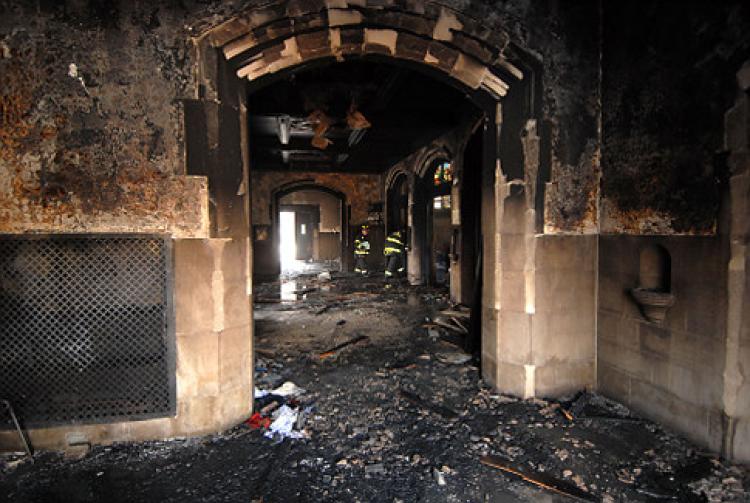
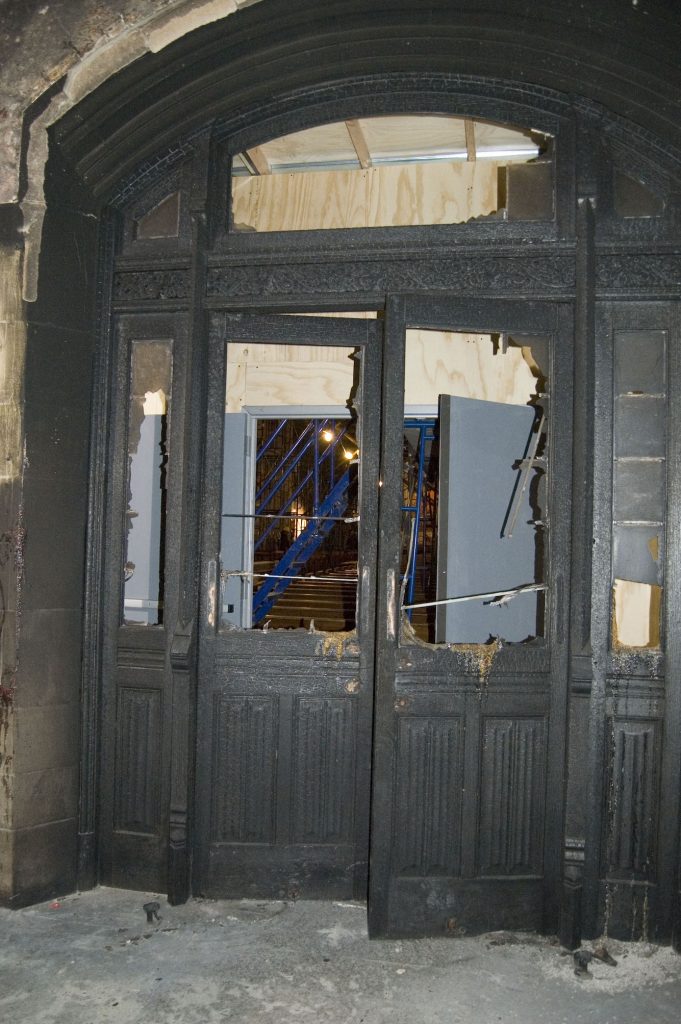
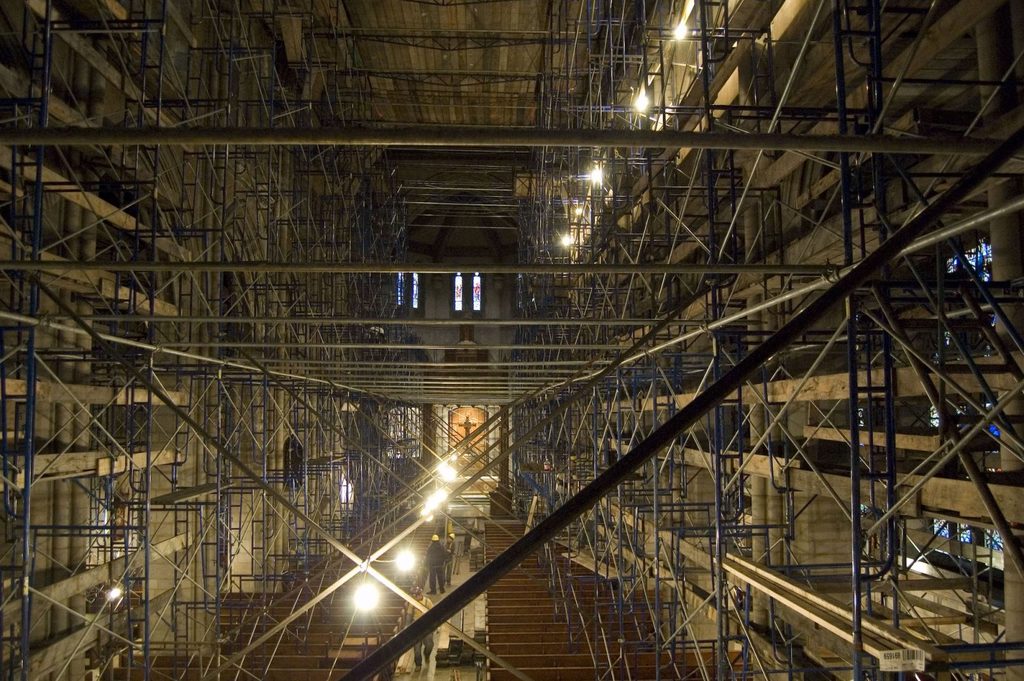
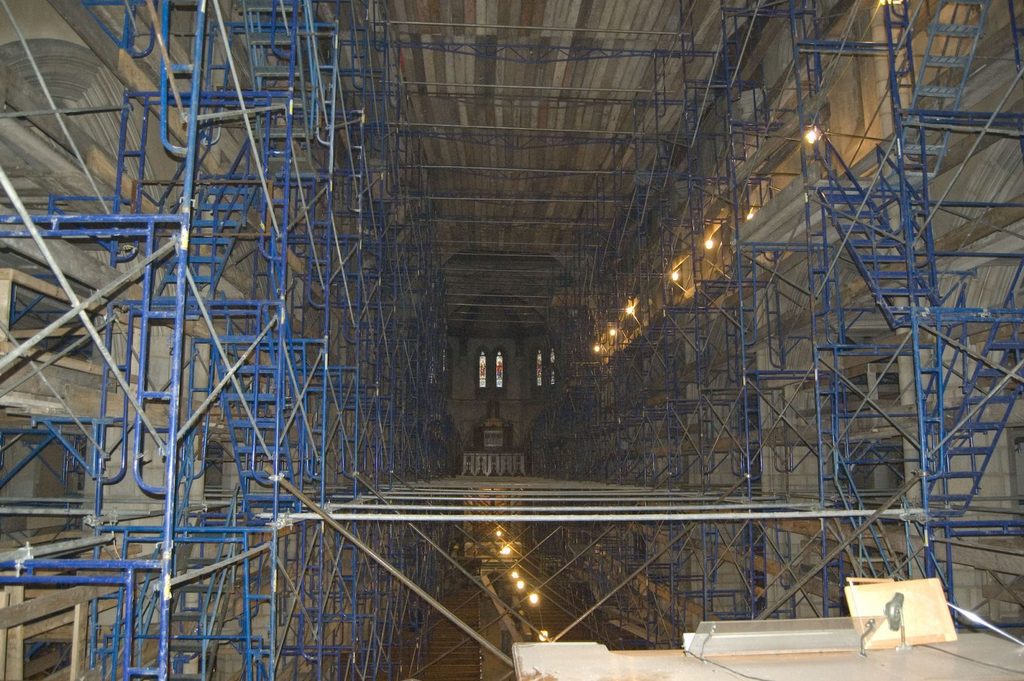
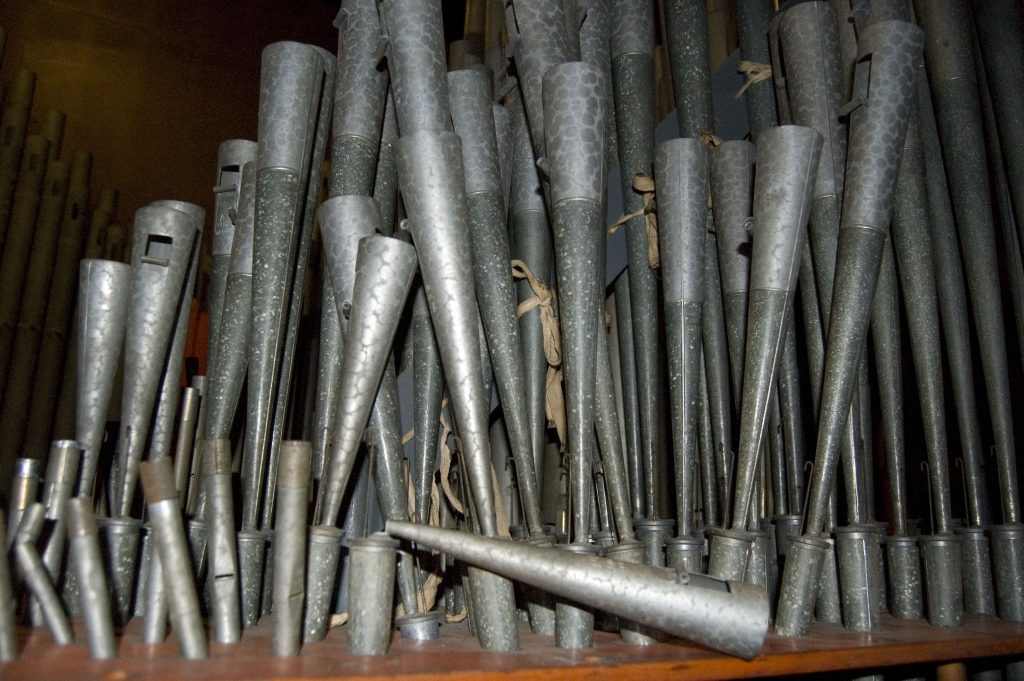
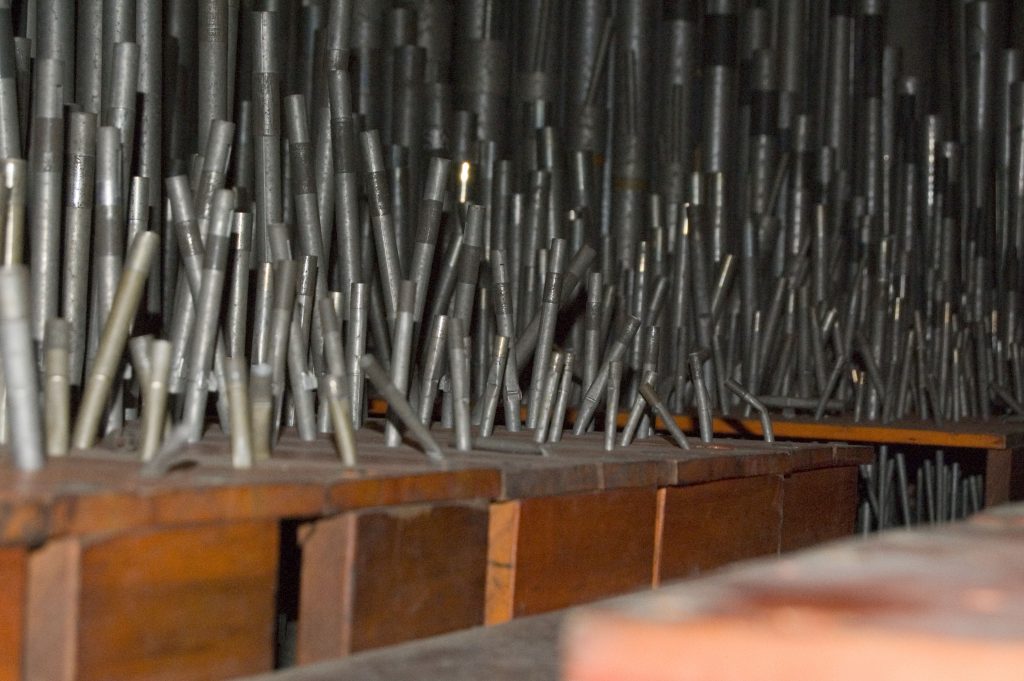
Grammar School Closes 2019
From around 2010, enrollment dwindled at our grammar school, with totals dropping to only 120 children in grades K-8 by 2018-19. The decreased enrollment was a reflection of the changing times, and sadly, there were no other alternatives but to close the school. During this same period, many other Catholic schools in New York City were closed also due to the lack of parents seeking Catholic education for their children. The school building (previously the high school located on Andrews Avenue) will remain the property of the Archdiocese of New York City, and will continue on as a school, but as a charter school, no longer under the auspices of the church. A final alumni/school closing mass was held on June 15, 2019. Pictures from this event can be seen by clicking here: Alumni/School Closing Mass.
We do want everybody to know that our church is doing quite well. We have record attendance and many projects are being completed to keep our church and parochial buildings in good shape. We have three very active communities – Spanish-speaking community, Vietnamese community, and English community, who work together to see that St. Nicholas of Tolentine Church continues the grand tradition its founders envisioned in 1907.
